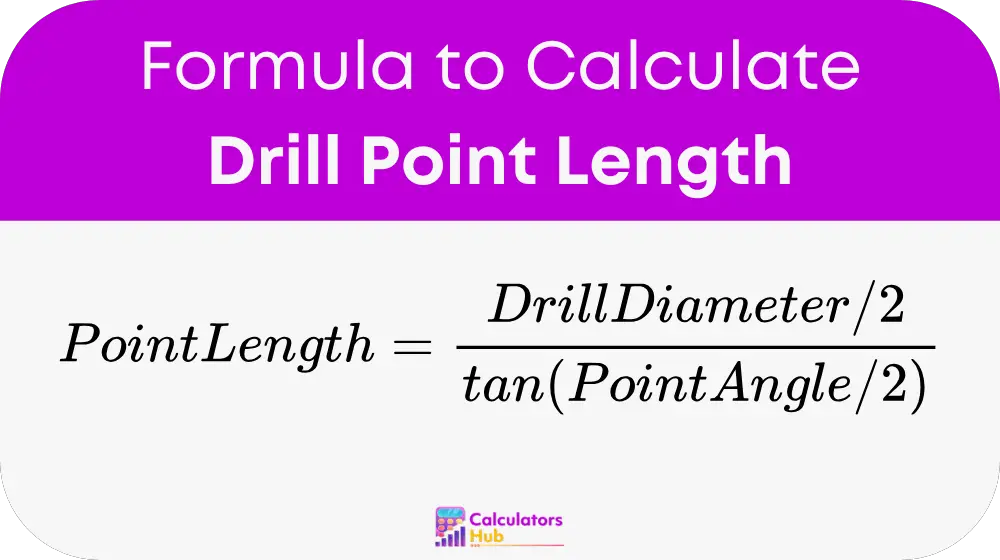The Drill Point Length Calculator is a specialized engineering and machining tool designed to compute the axial length of a drill bit’s conical tip. This measurement signifies the distance from the theoretical sharp point to where the full diameter of the drill bit begins. This calculator belongs to the essential machining and manufacturing tools category.
Its primary functions include:
- Determining the precise penetration depth before the drill bit’s full diameter engages the workpiece. This is vital for controlling hole depth accurately.
- Assisting users in selecting the most appropriate drill bit based on point angle and required drilling characteristics.
- Providing the necessary dimensions for correctly resharpening drill bits, ensuring the proper point geometry is maintained for efficient cutting.
- Helping to optimize drilling parameters, which can lead to improved hole quality, reduced tool wear, and increased safety.
By utilizing this calculator, professionals and hobbyists can enhance the precision of their drilling operations, prevent issues like drill wandering or excessive heat generation, and ensure consistent results across various materials and applications.
Formula of Drill Point Length Calculator
The calculation for drill point length relies on basic trigonometry, relating the drill’s diameter to its point angle. The standard formula is:

Where:
- Point Length is the axial length of the drill point, typically measured in millimeters (mm) or inches.
- Drill Diameter is the overall diameter of the drill bit, measured in the same units as the point length.
- Point Angle is the included angle at the very tip of the drill, measured in degrees.
- tan represents the tangent function used in trigonometry.
For quicker estimations, especially for common drill bit types, you can use these approximations:
- For a 118° point angle (standard for general-purpose drilling):
Point Length ≈ 0.30 × Drill Diameter - For a 135° point angle (often used for harder materials):
Point Length ≈ 0.27 × Drill Diameter - For a 90° point angle (suitable for softer materials or plastics):
Point Length ≈ 0.35 × Drill Diameter
These simplified multipliers offer a practical way to estimate the point length without needing a calculator for trigonometric functions.
Reference Table for Common Drill Sizes and Point Lengths
This table provides pre-calculated point lengths for common drill diameters and standard point angles, serving as a quick reference guide.
| Drill Diameter (mm) | Point Length (mm) for 118° | Point Length (mm) for 135° | Point Length (mm) for 90° |
|---|---|---|---|
| 1.0 | 0.30 | 0.27 | 0.35 |
| 3.0 | 0.91 | 0.81 | 1.06 |
| 5.0 | 1.51 | 1.35 | 1.77 |
| 6.0 | 1.81 | 1.62 | 2.12 |
| 8.0 | 2.42 | 2.16 | 2.83 |
| 10.0 | 3.02 | 2.70 | 3.54 |
| 12.0 | 3.63 | 3.24 | 4.24 |
| 16.0 | 4.84 | 4.32 | 5.66 |
| Drill Diameter (inches) | Point Length (inches) for 118° | Point Length (inches) for 135° | Point Length (inches) for 90° |
|---|---|---|---|
| 1/16 (0.0625) | 0.019 | 0.017 | 0.022 |
| 1/8 (0.125) | 0.038 | 0.034 | 0.044 |
| 1/4 (0.25) | 0.075 | 0.068 | 0.088 |
| 3/8 (0.375) | 0.113 | 0.101 | 0.132 |
| 1/2 (0.5) | 0.150 | 0.135 | 0.177 |
| 5/8 (0.625) | 0.188 | 0.169 | 0.221 |
| 3/4 (0.75) | 0.225 | 0.203 | 0.265 |
| 1 (1.0) | 0.300 | 0.270 | 0.354 |
Note: Values are rounded for practical use.
Example of Drill Point Length Calculator
Let’s calculate the point length for a common drill bit used for drilling into harder materials.
Given:
- Drill Diameter: 1/2 inch (0.5 inches)
- Point Angle: 135° (suitable for harder metals)
Calculation Steps:
- Find half the drill diameter:
Drill Diameter / 2 = 0.5 inches / 2 = 0.25 inches
- Find half the point angle:
Point Angle / 2 = 135° / 2 = 67.5°
- Calculate the tangent of half the point angle:
tan(67.5°) ≈ 2.4142
- Apply the formula:
Point Length = (Drill Diameter / 2) ÷ tan(Point Angle / 2)
Point Length = 0.25 inches ÷ 2.4142
Point Length ≈ 0.104 inches
Using the simplified formula for a quick estimate:
Point Length ≈ 0.27 × Drill Diameter
Point Length ≈ 0.27 × 0.5 inches = 0.135 inches
The exact calculation shows the point length is approximately 0.104 inches. This means the drill tip penetrates 0.104 inches before the full 1/2-inch diameter starts cutting the material. This knowledge is essential for precise depth control, especially when setting stops on a drill press or drilling blind holes.
Most Common FAQs
Knowing the point length is crucial for precise depth control in drilling. It tells you how far the tip penetrates before the full diameter engages, essential for tasks like drilling blind holes or ensuring correct pilot hole depth. It also aids in accurate drill bit resharpening.
The point angle influences how the drill interacts with the material. A standard 118° angle is versatile. Sharper angles (e.g., 90°) work better in soft materials, while flatter angles (e.g., 135°) provide more support for cutting harder materials, reducing wear and improving hole quality.
This formula is accurate for standard twist drills with a simple conical point. Specialized drill bits, such as those with split points, four-facet grinds, spade bits, or step drills, have different geometries and may require specific formulas or manufacturer data for accurate point length determination.